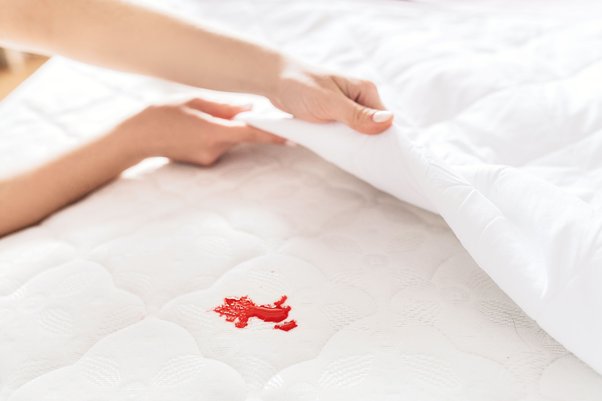How To Get Blood Out Of Sheets In 6 Easy Steps
Accidents happen, and when you find bloodstains on your sheets, it’s essential to take action quickly to prevent permanent damage. Whether it’s from a minor cut, a nosebleed, or a menstrual mishap, removing bloodstains from your sheets can be achieved with a few simple steps. Here’s a comprehensive guide on how to get blood out of sheets effectively.

Step 1: Act Promptly The first rule in bloodstain removal is to act swiftly. The sooner you address the stain, the better your chances of success. Fresh bloodstains are much easier to remove than dried ones, as the proteins in the blood haven’t had a chance to set in the fabric. So, don’t delay—begin the stain-removal process as soon as you notice the stain.
Step 2: Rinse With Cold Water Before doing anything else, gently rinse the stained area under cold, running water. The coldwater helps prevent the blood proteins from coagulating and setting in the fabric. Be cautious not to use hot water, as it can have the opposite effect and make the stain more challenging to remove.

Step 3: Pre-Treat the Stain After the initial rinse, it’s time to pre-treat the bloodstain. There are a few effective methods for pre-treatment:
- Hydrogen Peroxide: Dab a small amount of hydrogen peroxide directly onto the stain. Hydrogen peroxide is a mild bleach that can help break down the proteins in the blood. Gently rub the stained area with a soft cloth or a toothbrush, being careful not to scrub too vigorously to avoid damaging the fabric.
- Salt Paste: Another option is to create a paste using cold water and salt. Apply the paste to the stain and gently rub it with a cloth or a toothbrush. Salt is known for its ability to absorb moisture and lift stains.
Step 4: Launder As Usual Once you’ve pre-treated the stain, it’s time to launder your sheets as you normally would. Use cold water for washing, and consult the care label on your sheets for any specific washing instructions or restrictions. Your regular laundry detergent should work well. Be sure to inspect the sheets before proceeding to the next step.
Step 5: Inspect After Washing After washing, check the stained area to ensure that the bloodstain is entirely gone. If any traces remain, avoid drying your sheets, as heat can set the stain. Instead, repeat the pre-treatment and washing process until the stain is no longer visible.
Step 6: Air Dry Once the bloodstain is successfully removed, allow your sheets to air dry. Drying them in high heat, such as in a dryer, can set any remaining traces of the stain, making it significantly more challenging to remove in the future. By air drying, you ensure that the stain removal process is complete and successful.
It’s important to note that particularly stubborn or old bloodstains may require professional cleaning. Additionally, refrain from using bleach on bloodstains, as it can worsen the situation by setting the stain rather than removing it.
Stain Removal Techniques
Stains can be pesky, no matter where they appear. Whether it’s a spill on your favorite shirt or a mark on your upholstery, knowing effective stain removal techniques can be a game-changer. Here are some key approaches to tackle stains:
Identify the Stain: The first step in stain removal is understanding the nature of the stain. Is it a water-based stain, an oil-based stain, or something more specific like red wine or blood? Knowing the stain’s composition will guide your treatment.
Act Quickly: The golden rule of stain removal is to act promptly. Fresh stains are easier to remove than old, set-in ones. Blot or scrape off excess residue without rubbing it in further.
Test an Inconspicuous Area: Before applying any stain removal method, test it on a hidden or inconspicuous area to ensure it won’t cause damage or discoloration to the material.
Use the Right Cleaning Agent: Depending on the stain type, use an appropriate cleaning agent. Common choices include cold water, mild detergent, hydrogen peroxide, vinegar, baking soda, or specialized stain removers.
Blot, Don’t Rub: When treating a stain, blot it with a clean cloth or paper towel, working from the outside of the stain toward the center. Rubbing can push the stain deeper into the fabric.
Follow Care Instructions: Always follow the care label on clothing or fabric for specific cleaning instructions. Some items may require professional cleaning.
Rinse Thoroughly: After applying a cleaning agent, rinse the area thoroughly to remove any residue. Ensure it’s completely dry before using the item again.
Persistence: Stubborn stains may require multiple treatments. Be patient and persistent, repeating the process until the stain is gone.
Bloodstain Removal Hacks
Bloodstains can be particularly challenging, but there are some effective hacks to tackle them:
Cold Water: Always start with cold water. Hot water can set blood stains, so cold water is your best ally.
Hydrogen Peroxide: A mixture of hydrogen peroxide and cold water can be a powerful bloodstain remover. Apply it directly to the stain and gently blot.
Salt Paste: Create a paste with cold water and salt and apply it to the stain. Let it sit for a while before rinsing.
Meat Tenderizer: For older bloodstains, a paste made from meat tenderizer and water can help break down the proteins in the blood.
Aspirin Solution: Dissolve an aspirin tablet in water and apply the solution to the stain. Let it sit for a while and then rinse.
Lemon Juice and Salt: Combine lemon juice and salt into a paste and apply it to the stain. Allow it to sit and then rinse with cold water.
Cleaning Blood Off Bedding
Cleaning blood off bedding requires a gentle touch:
Act Quickly: As with any stain, the sooner you address it, the better. Begin by rinsing the stained area under cold, running water.
Pre-Treat: Apply a stain-removing agent like hydrogen peroxide or a salt paste to the stain. Gently rub the stain, being careful not to damage the fabric.
Launder As Usual: Wash your bedding in cold water with regular detergent, following care label instructions.
Inspect After Washing: Before drying, check if the stain is gone. If it persists, repeat the pre-treatment and washing process.
Air Dry: Avoid high heat when drying your bedding to prevent setting any remaining traces of the stain.
Removing Blood from White Sheets
White sheets can be particularly challenging when it comes to stains. Here’s how to remove blood from white sheets effectively:
Follow the General Steps: Use the same stain removal techniques mentioned earlier but with the understanding that white fabric can handle more robust stain removal agents.
Hydrogen Peroxide: When treating white sheets, hydrogen peroxide is a powerful ally. It can help break down blood proteins and restore the fabric’s whiteness.
Extra Rinse: After the stain is gone, consider giving your white sheets an extra rinse to ensure all stain-removing agents are thoroughly removed.
These stain removal techniques, bloodstain removal hacks, and cleaning tips are valuable for maintaining the cleanliness and longevity of your bedding and fabrics. Be patient and persistent, and you’ll increase your chances of success in keeping your linens spotless.
More detail on mattresses
